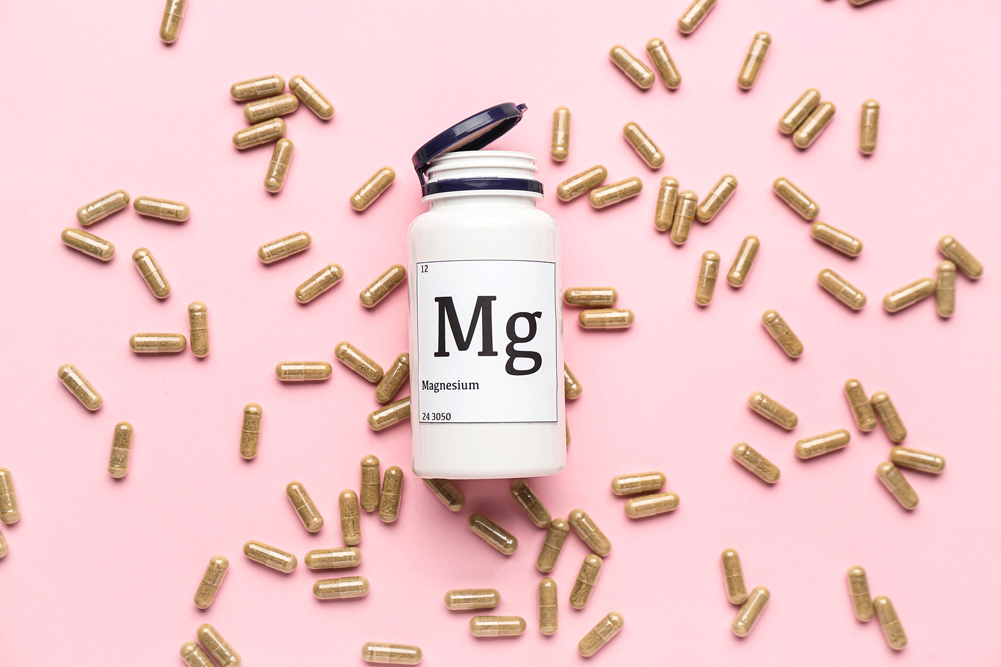In May of 2013, I wrote an article for Vitamin Retailer titled, “Magnesium: A Mineral With Multiple Applications.” At that time, magnesium was already a trending nutraceutical in the dietary supplement industry—but that was only the beginning. In 2024 the magnesium market size was valued at $29.3 billion with estimations to reach $40.8 billion by 2030.1
Furthermore, over the past few years so many new forms of magnesium have been introduced into the market that I’ve referred to the phenomenon as “the magnesium flavor of the month.” These include—but are not limited to—magnesium oxide, magnesium citrate, magnesium glycinate, magnesium malate, magnesium chloride, magnesium sulfate, magnesium lactate, magnesium taurate, magnesium L-threonate, magnesium aspartate, magnesium hydroxide, magnesium carbonate … the list goes on. But with so many forms of magnesium available, how is it possible to assess which form is good, which is better, and which is best? This article will explore this enigma.
Fundamental Roles of Magnesium
Let’s start with an overview of the fundamental role that magnesium plays in the body. To reiterate what I wrote in my previous article, magnesium is an essential mineral with multiple functions in the human body. This includes a structural role in bone, cell membranes and chromosomes. It is needed for more than 300 metabolic reactions, including magnesium-dependent chemical reactions required to metabolize carbohydrates and fats in the production of adenosine triphosphate (ATP), the “energy currency” of the body. In addition, magnesium is required for the synthesis of nucleic acids, proteins, carbohydrates, lipids and the antioxidant glutathione. Magnesium is also required for transporting potassium and calcium ions across cell membranes. The conduction of nerve impulses, muscle contraction, normal heart rhythm, cell signaling and cell migration, which may be important in wound healing,2 are also all magnesium-dependent activities.
Magnesium Adequacy
So now that we have a better understanding of the importance of magnesium to human health, how much do we need? The daily value for magnesium is 420 mg for adults and children age 4 years and older.3 But how many people are meeting this intake? According to the National Institutes of Health, Office of Dietary Supplements,4 dietary surveys of Americans consistently show that many consume less than recommended amounts of magnesium. An analysis of data from the National Health and Nutrition Examination Survey (NHANES) of 2013-2016 found that 48 percent of Americans of all ages ingest less magnesium from food and beverages than their respective estimate adequate intakes. For example, adult men age 71 years and older and adolescent males and females are most likely to have low intakes. Using data from NHANES 2003-2006 to assess mineral intakes among adults, average intakes of magnesium from food alone were higher among users of dietary supplements (350 mg for men and 267 mg for women, than among nonusers (268 mg for men and 234 for women). In any case, a great number of Americans do not have a sufficient intake of magnesium. This certainly supports the case for magnesium supplementation.
The 3 Methods for Assessing the Value of Different Forms of Magnesium
Now that we know magnesium supplementation is important, which form of magnesium should we choose? In my opinion, there are three different methods for assessing the value of different forms of magnesium. The first is to look at magnesium bioavailability. The second is to look at elemental potency. The third is to look at the efficacy of each form for promoting one or more aspects of human health and wellness. While each method has merit, neither alone tells the full story. For this reason, I recommend the collective use of each method. In any case, let’s start by looking at bioavailability.
Magnesium Bioavailability
Since there are too many forms of magnesium to review in this article, I’ll limit the discussion to some of the more popular forms of magnesium. It should be noted that it is not simple to provide an accurate apples-to-apples comparison of the different magnesium forms by comparing different studies which may have used different methodologies for assessing bioavailability. Consequently, I’m only going to cite studies in which various forms of magnesium were compared within a given study, and in which human subjects were used.
Magnesium Comparison Study 1
In this study,5 each subject was administered 350 mg elemental magnesium as Sucrosomial magnesium (distributed in the U.S. by Maypro), magnesium citrate, magnesium oxide and magnesium bisglycinate. Blood levels of magnesium increased as follows:
• Sucrosomial magnesium: 6.74 percent and 8.29 percent at four hours and 24 hours
• Magnesium bisglycinate: 4.5 percent and 5.45 percent at four hours and 24 hours
• Magnesium citrate: 5.03 percent and 4.52 percent at four hours and 24 hours
• Magnesium oxide: 2.44 percent and 1.95 percent at four hours and 24 hours.
Magnesium Comparison Study 2
In this study,6 each subject was administered 350 mg elemental magnesium as MagShape microcapsules, magnesium bisglycinate, magnesium citrate and magnesium oxide. Blood levels of magnesium increased as follows:
• MagShape microcapsules: 7.9 percent, 7.5 percent and 8.8 percent after one, four and six hours, respectively
• Magnesium bisglycinate: Not significant at any time point
• Magnesium citrate: 7.5 percent after four hours
• Magnesium oxide: 7.1 percent after one hour.
Magnesium Elemental Potency
Magnesium doesn’t naturally exist by itself. Rather it is attached to some type of organic or inorganic acid. Minerals attached to acids are called mineral salts. All forms of magnesium used in dietary supplements provide one or more magnesium salt. For example, if you attached citric acid to magnesium, you would have a magnesium salt called magnesium citrate. This would provide about 16 percent elemental magnesium.7 By comparison, magnesium oxide is about 58 percent elemental magnesium—a much, much higher elemental potency. That means to obtain 400 mg of elemental magnesium you’d have to consume about 2,500 mg of magnesium citrate or 690 mg of magnesium oxide. That’s easily more than triple the amount of magnesium citrate you’d have to take compared to magnesium oxide tablets. Here are the elemental potencies of some of the different forms of magnesium, as well as the dose you’d have to use to yield 400 mg of elemental magnesium:
Balancing Bioavailability Against Elemental Potency
So, it is clear that some forms of magnesium have better bioavailability, while others have better elemental potency. Specifically, Sucrosomial magnesium and MagShape microcapsules both have the highest comparative bioavailability. With the exception of magnesium oxide, these two also have the highest elemental potency. Consequently, I’d give Sucrosomial magnesium and MagShape microcapsules an “A” grade (best). Magnesium oxide has the highest elemental potency, although it has comparatively lower—albeit acceptable—bioavailability. I’d give magnesium oxide a “B” grade (better than good). Magnesium citrate has much lower elemental potency, but reasonably good bioavailability. I’d give it a C+ (good). Magnesium bisglycinate has mixed reviews on bioavailability as well as substantially lower elemental potency. I’d give it a “C-” grade.
Since magnesium chloride, magnesium gluconate and magnesium L-threonate lack comparative bioavailability data in humans, I give it a grade of “incomplete.” Also, magnesium gluconate and magnesium L-threonate have very low elemental potencies.
Magnesium Efficacy
It should be noted that some forms of magnesium have studies demonstrating efficacy for specific purposes even if they have lower elemental potencies. For example, magnesium L-threonate was shown to improve sleep quality, improve mood, energy, alertness and daily activity and productivity at a dose of 1,000 mg/day,8 and improving cognitive function in older adults at a dose of 2,000 mg/day.9 Conversely, a sleep study10 with 500 mg/day of magnesium from high elemental potency magnesium oxide (862 mg) both subjective (e.g. sleep efficiency, sleep time, sleep onset latency) and objective measures of insomnia (e.g. melatonin, serum cortisol).
Of course, some forms of magnesium with higher elemental potencies have also been shown to have specific benefits. For example, Sucrosomial magnesium was shown to promote healthy bone density.11
Conclusion
In consideration of all these facts, here’s my bottom line. If the goal of the dietary supplement is to provide a substantial amount of magnesium, then I’d recommend using forms with higher elemental potencies: Sucrosomial magnesium, MagShape microcapsules or magnesium oxide. If you also want the source to have strong bioavailability claims, then I’d limit the choices to just the former two. If, on the other hand, you’re more interested in addressing a specific health/wellness concern, then choose the form and dose of magnesium shown in human research to have that benefit. In this instance, the elemental potency and bioavailability is less important since you already have evidence of efficacy.VR
References:
1 Magnesium – Nutritional Supplements Market Statistics. Horizon Grand View Research. Retrieved May 27, 2025 from https://www.grandviewresearch.com/horizon/statistics/nutritional-supplements-market/minerals/magnesium/global.
2 Rude RK, Shils ME. Magnesium. In: Shils ME, Shike M, Ross AC, Caballero B, Cousins RJ, eds. Modern Nutrition in Health and Disease. 10th ed. Baltimore: Lippincott Williams & Wilkins; 2006:223-247.
3 U.S. Food and Drug Administration. Food Labeling: Revision of the Nutrition and Supplement Facts Labels. 2016.
4 Magnesium. National Institutes of Health, Office of Dietary Supplements. Updated: June 2, 2022. Retrieved May 27, 2025 from https://ods.od.nih.gov/factsheets/Magnesium-HealthProfessional/#:~:text=free percent20 percent5B21 percent5D.-,Magnesium percent20Intakes percent20and percent20Status,proxy percent20for percent20assessing percent20magnesium percent20status.
5 Brilli E, Khadge S, Fabiano A, Zambito Y, Williams T, Tarantino G. Magnesium bioavailability after administration of sucrosomial magnesium: results of an ex-vivo study and a comparative, double-blinded, cross-over study in healthy subjects. Eur Rev Med Pharmacol Sci. 2018;22(6):1843-1851. doi:10.26355/eurrev_201803_14605.
6 Pajuelo D, Meissner JM, Negra T, Connolly A, Mullor JL. Comparative Clinical Study on Magnesium Absorption and Side Effects After Oral Intake of Microencapsulated Magnesium (MAGSHAPET Microcapsules) Versus Other Magnesium Sources. Nutrients. 2024;16(24):4367. Published 2024 Dec 18. doi:10.3390/nu16244367.
7 Klasco RK (Ed): USP DI Drug Information for the Healthcare Professional. Thomson MICROMEDEX, Greenwood Village, Colorado 2003.
8 Hausenblas HA, Lynch T, Hooper S, Shrestha A, Rosendale D, Gu J. Magnesium-L-threonate improves sleep quality and daytime functioning in adults with self-reported sleep problems: A randomized controlled trial. Sleep Med X. 2024;8:100121. Published 2024 Aug 17. doi:10.1016/j.sleepx.2024.100121.
9 Liu G, Weinger JG, Lu ZL, Xue F, Sadeghpour S. Efficacy and Safety of MMFS-01, a Synapse Density Enhancer, for Treating Cognitive Impairment in Older Adults: A Randomized, Double-Blind, Placebo-Controlled Trial. J Alzheimers Dis. 2016;49(4):971-90. doi: 10.3233/JAD-150538. PMID: 26519439; PMCID: PMC4927823.
10 Abbasi B, Kimiagar M, Sadeghniiat K, Shirazi MM, Hedayati M, Rashidkhani B. The effect of magnesium supplementation on primary insomnia in elderly: A double-blind placebo-controlled clinical trial. J Res Med Sci. 2012 Dec;17(12):1161-9. PMID: 23853635; PMCID: PMC3703169.
11 Scaturro D, Vitagliani F, Terrana P, Tomasello S, Camarda L, Letizia Mauro G. Does the association of therapeutic exercise and supplementation with sucrosomial magnesium improve posture and balance and prevent the risk of new falls? Aging Clin Exp Res. 2022;34(3):545-553.
Gene Bruno, DBM, MHS, Professor Emeritus of Nutraceutical Science, is a writer, educator and a nutraceutical scientist with more than 45 years of experience educating natural product retailers and health care professionals and formulating natural products for dozens of dietary supplement companies. He has written articles on nutrition, herbal medicine, nutraceuticals and integrative health issues for trade, consumer magazines and peer-reviewed publications. Bruno also hosts “The Vitamin Professor Podcast” brought to you by VRM Media. He can be reached at eugenejbruno@gmail.com.



